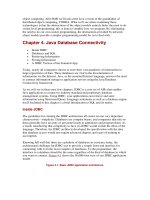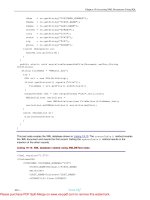Java database connectivity
Bạn đang xem bản rút gọn của tài liệu. Xem và tải ngay bản đầy đủ của tài liệu tại đây (225.86 KB, 25 trang )
object computing. After RMI we'll look at the Java version of the grandfather of
distributed object computing, CORBA. What we'll see when examining these
technologies is that the abstractions of the object models entirely hides the need to do
socket level programming; this is done to simplify how we program. By eliminating
the need to do our own socket programming, the abstractions provided by network
object models provide a simpler programming model for us to deal with.
Chapter 4. Java Database Connectivity
•
Inside JDBC
•
Databases and SQL
•
Retrieving Information
•
Storing Information
•
A JDBC Version of the Featured App
Today, nearly all companies choose to store their vast quantities of information in
large repositories of data. These databases are vital to the dissemination of
information via the Internet. Java, as the anointed Internet language, answers the need
to connect information storage to application servers using the Java Database
Connectivity framework.
As we will see in these next few chapters, JDBC is a core set of APIs that enables
Java applications to connect to industry standard and proprietary database
management systems. Using JDBC, your applications can retrieve and store
information using Structured Query Language statements as well as a database engine
itself. Included in this chapter is a brief introduction to SQL and its merits.
Inside JDBC
The guidelines for creating the JDBC architecture all center on one very important
characteristic—simplicity. Databases are complex beasts, and companies that rely on
them generally have an army of personnel ready to administer and program them. As
a result, transferring that complexity to Java via JDBC would violate the ethos of the
language. Therefore, the JDBC architects developed the specification with the idea
that database access would not require advanced degrees and years of training to
accomplish.
Knowing full well that there are a plethora of databases in existence today, the
architectural challenge for JDBC was to provide a simple front-end interface for
connecting with even the most complex of databases. To the programmer, the
interface to a database should be the same regardless of the kind of database to which
you want to connect. Figure 4-1 shows the 50,000-foot view of our JDBC application
model.
Figure 4-1. Basic JDBC application architecture.
Database Drivers
In the world of distributed computing it is easier to understand databases if we think
of them as devices rather than software. First of all, we usually install databases on
separate machines that are network accessible, and second, we almost always access
the database through a standardized driver rather than using native interfaces. If we
think of our database as a device, the idea of a driver makes more sense due mainly to
our preconceived ideas (and experiences) with having to install device drivers every
time we want to add a new card or peripheral device to our workstation.
Standardized drivers for databases came about in much the same way that many other
ad hoc standards get developed; in the case of databases, Microsoft developed Open
Database Connectivity as a standard for Windows applications to connect to and use
Microsoft databases. ODBC became so popular so fast that other database vendors
saw the writing on the wall for proprietary APIs and databases whose interface was
based on proprietary APIs that they quickly came out with ODBC drivers for their
databases. This allowed anyone's database to be accessed from a Windows application
in exactly the same way that a Microsoft database would be accessed. ODBC was
designed into Windows, and the coupling between it and Microsoft databases was
extremely tight and performance-oriented. Other database vendors took a slightly
different approach to ODBC; they built an ODBC interface that then translated ODBC
into their native API calls. This puts an extra layer between the application and the
database. This type of driver is the reason that ODBC has gotten a bad rap on some
database platforms.
JDBC takes a number of approaches to database connectivity, and it is important to
remember that JDBC is really a published standard interface to databases similar to
ODBC. There are currently four common approaches to database connectivity each
with a corresponding driver type.
Type 1 Drivers.
The JDBC-ODBC bridge driver takes the simple approach of translating JDBC calls
to equivalent ODBC calls and then letting ODBC do all the work. Drivers of this type
require that an ODBC driver also be installed on each workstation and that some
proprietary libraries (Vendor APIs) that help with the JDBC to ODBC conversion
must also be installed. Although effective, these drivers provide relatively low
performance due to the extra software layer(s). This driver is handy for putting
together application prototypes for "early on" customer demonstrations; because you
do not have to install a full blown relational database management system, this is one
place where MS Access is a perfectly fine tool. There is a caveat with using MS
Access databases: Always remember that an .mdb file is just that, a file (not a
database management system). The ODBC driver makes .mdb files appear to be
database management systems. Now here is the caveat, the ODBC drive must be able
to find the .mdb file on a mapped drive (i.e., the .mdb file can be anywhere on your
LAN that the ODBC driver [on the machine] you are using as your data server can
find via a mapped drive). This means that, if the database is on a machine that only
has TCP/IP connectivity, you are out of luck. This also means that, if you are a UNIX
user, you are normally out of luck and must resort to using RDBMs even for
prototypes. See Figure 4-2 for an architectural view of a type one driver application.
Figure 4-2. Type 1 JDBC/ODBC bridge.
In the case of Microsoft databases like Access and SQL Server, which are designed
around ODBC, the ODBC driver to database connection is direct and the only extra
layer involved is the conversion from JDBC to ODBC. In the case of other vendors'
databases that have their own native APIs, there can be an additional conversion from
ODBC to the vendor's native API.
An additional thing we need to remember when programming for the Enterprise is
that, in the case of Java applets, an applet can only make a network connection back
to the machine (IP address) that it was served from. This requires that our database be
running on the same machine as our Web server. This could have some serious
implications from the standpoint of overall performance for a busy Web site. In most
cases, the best solution to this problem is to not use a type 1 driver. Instead, use
another driver type and pick a three-tier architecture rather than the two-tier approach
of the type 1 driver.
Type 2 Drivers.
Drivers in this category typically provide a partial Java, partial native API interface to
the database. Typical of this type of driver is the driver provided by IBM for its DB2
Universal Database (UDB). UDB provides a native driver in the form of the DB2
Client Enabler (CAE), which must be installed on each client machine. The CAE
installs a rather elaborate set of driver software that allows access to any DB2
database to which the client machine has network connectivity. Along with the CAE
comes a JDBC driver. The JDBC driver is placed in your virtual machine's
CLASSPATH. Once loaded by the JDBC Driver Manager and a database connection
is established your application has a fairly high-performance pipe to the database.
Figure 4-3 illustrates this architecture.
Figure 4-3. Type 2 DB2 JDBC driver.
DB2 (and most other modern databases) can be configured to do connection pooling
at the database; this doesn't really constitute a three-tier solution, it is still a two-tier
(maybe pseudo three-tier) solution.
Type 3 Drivers.
Drivers of this type are usually called network protocol drivers and convert the JDBC
calls into a database independent protocol that is transmitted to a middleware server
that translates the network protocol into the correct native protocol for the target
database. The middleware server is usually run on an independent, high-performance
machine and has the ability to convert the network protocol to the required native
protocols for a number of different database vendors' products. It also is the JDBC
driver source for the client driver manager. The middle tier usually uses a type 1 or 2
driver for its connectivity to the database. Because many databases are good places to
store and retrieve information (but are poor connection managers), the middle-tier
server often has the job of being a connection manager for the databases (i.e., when
started up, a number of database connections are established and held open; the
middleware then acts as a router, routing database transactions to already open
database connections). The beauty of this is that the end user never incurs the penalty
of establishing the connection (which is considerable) to the database. Figure 4-4
illustrates this architecture.
Figure 4-4. Type 3 driver.
Type 4 Drivers.
Last but not least is the all Java, type 4 driver (see Figure 4-5). These drivers require
no special software to be installed on client machines and are typically provided by
database vendors or vendors like Intersolv and Hit Software that specialize in
database drivers. Solutions that use type 4 drivers are typically two-tier, but with the
connection pooling that most databases currently provide we have that previously
mentioned pseudo three-tier architecture. These drivers are perfect for applet-based
clients as everything required by the client is self-contained in the client download
from the Web server.
Figure 4-5. Type 4 driver.
In the desktop world, a driver enables a particular piece of hardware to interface with
the rest of the machine. Similarly, a database driver gives JDBC a means to
communicate with a database. Perhaps written in some form of native code but
usually written in Java itself, the database drivers available for JDBC are wide and
varied, addressing several different kinds of databases.
The JDBC API is available for users as part of the JDK. The JDBCODBC bridge is
supplied as part of the JDK; other drivers are available from the database vendors or
driver specialty companies.
The DriverManager Object.
At the heart of JDBC lies the DriverManager. Once a driver is installed, you need to
load it into your Java object by using the DriverManager. It groups drivers together so
that multiple databases can be accessed from within the same Java object. It provides
a common interface to a JDBC driver object without having to delve into the internals
of the database itself.
The driver is responsible for creating and implementing the Connection, Statement,
and ResultSet objects for the specific database, and the DriverManager then is able to
acquire those object implementations for itself. In so doing, applications that are
written using the DriverManager are isolated from the implementation details of
databases, as well as from future enhancements and changes to the implementation
itself, as you can see in Figure 4-6.
Figure 4-6. The Driver abstracts the connection, statement, and ResultSet objects from
the application.
Database Connection Interface.
The Connection object is responsible for establishing the link between the Database
Management System and the Java application. By abstracting it from the
DriverManager,
the driver can isolate the database from specific parts of the
implementation. It also enables the programmer to select the proper driver for the
required application.
The
Connection.getConnection
method accepts a URL and enables the JDBC
object to use different drivers depending on the situation, isolates applets from
connection-related information, and gives the application a means by which to specify
the specific database to which it should connect. The URL takes the form of
jdbc:<subprotocol>:<subname>.
The subprotocol is a kind of connectivity to the
database, along the lines of ODBC, which we shall discuss in a moment. The subname
depends on the subprotocol but usually allows you to configure the database that the
application will look at.
Database Statement Object.
A Statement encapsulates a query written in Structured Query Language and enables
the JDBC object to compose a series of steps to look up information in a database.
Using a Connection, the Statement can be forwarded to the database and obtain a
ResultSet.
ResultSet Access Control.
A
ResultSet
is a container for a series of rows and columns acquired from a
Statement
call. Using the
ResultSet
's iterator routines, the JDBC object can step
through each row in the result set. Individual column fields can be retrieved using the
get methods within the
ResultSet.
Columns may be specified by their field name or
by their index.
JDBC and ODBC.
In many ways, Open Database Connectivity (ODBC) was a precursor to all that JDBC
is intended to accomplish. It adequately abstracts the boring tedium of databases, and
the proprietary APIs to those databases, from the application programmer; it ties many
different kinds of databases together so that you only have to create one source file to
access them; and it is fairly ubiquitous. Recognizing the relative acceptance of ODBC
technology, JDBC offers a JDBC-to-ODBC driver free with the JDK.
With this, JDBC applications can talk to the same database access engine as non-Java
applications. Furthermore, integrating JDBC into your existing business process can
be done fairly easily because the bridge ensures that no additional work is required to
enable Java Database Connectivity.
NOTE
Because of copyright restrictions, we are unable to supply these drivers on the CD-
ROM, but you may visit the JDBC page on the JavaSoft Web site at
java.sun.com/jdbc and get the latest information on drivers and the pointers to
them.
As you can see, the JDBC application communicates with the database using the same
existing OLE or COM protocol. Furthermore, any administration issues associated
with the database are negligible because the existing administration strategy is still
applicable. Application programmers need know only that the ODBC bridge will be
used and that they should not tailor their application to it.
Installing the ODBC driver for Windows will be discussed in the next section.
Because it is a Microsoft product, the process is easy, but the reliability is in doubt.
Keep in mind that most mission-critical applications are run using heavy-duty,
workstation-based databases. These databases are expensive and difficult to
administer but they are more reliable than a Microsoft Access solution. In any event,
we will show you how to write applications tailored for Microsoft because the general
computing populace, and more importantly the audience of this book, will not
necessarily have access to database servers like Sybase, DB2, or Oracle.
JDBC in General
Java Database Connectivity encapsulates the functionality of databases and abstracts
that information from the end user or application programmer. Creating simple JDBC
applications requires only minor knowledge of databases, but more complex
applications may require intensive training in database administration and
programming. For that reason, we have chosen several simple and fun examples to
display the power of a Java solution that will more likely than not be used by mission-
critical applications.
So far we have only addressed the use of JDBC on Windows-based
platforms. We, as application developers and architects, shouldn't lose sight
of the fact that JDBC works on any platform that supports the version 1.1 (or
newer) Java Virtual Machine. This includes many UNIX platforms from
IBM, Sun, and HP to name a few and mainframe computers like IBM's
OS390, VM/CMS and its midrange OS/400-based computers. On all these
platforms JDBC provides a consistent interface to relational databases native
to these platforms. Almost all modern relational database management
systems provide TCP/IP-based access to their data stores via SQL. This gives
us as enterprise application developers connectivity from virtually any Java-
based client to any relational database on any host platform.
Databases and SQL
Databases are storage mechanisms for vast quantities of data. An entire segment of
the computer industry is devoted to database administration, perhaps hinting that
databases are not only complex and difficult but also best left to professionals.
Because of this level of difficulty and of our desire to get you started in linking Java
to databases, we have chosen to implement a widely available, easily administered,
and simply installed database. Microsoft Access can be purchased at your local
software retailer. If you want to get started, it's a good place to start. From there, you
can move on to more complex databases such as Oracle and Sybase.
In this section, we intend to introduce and create a simple database. In the next section,
you will create a simple Java client that accesses the database and gets information
from it. We suggest that further exploration into JDBC be preceded by a serious
investigation into SQL (any of the currently available texts on Relational Database
Management Systems will suffice; check Amazon.com for currently available texts).
The Structured Query Language enables you to create powerful instructions to access
databases. Once you grasp SQL, you will be able to understand the reasoning and
theories behind JDBC.
Creating an Access Database
We will need to first start Microsoft Access so that we can create a database to talk to.
This is an important step, but one that those who either do not have access to or who
do not wish to use Microsoft's database can tailor for their own database. After
starting Access:
1. Select "Database Wizard" so Access will help you create a database.
2. Select the "Blank Database" icon.
3. Name the database and then you will get a series of tabbed folders. Go to
"Tables" and click on "New."
4. You will get a spreadsheet-like view in which you can enter your data.
5. Enter your data as shown in Figure 4-7 and then select "Save" to store the
table to the database. Name your table PresidentialCandidate.
Figure 4-7. Our database entry.
As you can see in Figure 4-7, we entered the important statistics from the last
presidential election. The percentage is stored as a whole number, not as a decimal.
This allows the application to determine how it will represent the information. We
also store the electoral votes that each candidate received.
Simple SQL
Now that we've put the statistical data about the candidates into our database table, we
can use Access to help us design the queries that we will need for our GUI. To do so,
we need to know a little bit of SQL. This is by no means intended to be the be-all and
end-all of SQL tutorials. This is a Java book, and as such we will minimize our
discussion of SQL. Suffice it to say that, for a programming language that has no
program control statements and is completely declarative, it is extremely powerful.
The most often used instruction in SQL is the Select statement. Select enables you to
retrieve a copy of specific portions of a database table. As part of the Select statement,
you must specify both the database table from which you want the information and a
filter for the information (if required). So, when you Select From a table Where the
parameters match your requirements, you get a result back.
SELECT column list FROM myTable WHERE filter
The Where clause of the Select statement may contain what is known as a filter.
Filters are specified as conditionals and enable you to further tailor the match
parameters for a database query. In a moment, we will query a database table for all
the presidential candidates who received electoral votes in the 1996 election. From a
field of three candidates, we will end up with two. Big party politics aside, our query
will return a result based on the parameters we specify.
In theory, that result always will be a database table of its own. For example, given
the following table of presidential election results and the accompanying SQL
statement, we will receive a table in return (see Figure 4-8).
Figure 4-8. SQL statement can be made to return entire tables.
This table is like a local variable. It disappears from memory if we don't use it right
away. Using JDBC, this results table is saved for us to retrieve the results data from
an object called a ResultSet, which will go away (be garbage collected) when the
object goes out of scope. We could just as easily include this SQL statement within
another SQL statement and achieve predictable results. These are called subqueries
and are another powerful tool of which SQL programmers can take advantage.
The beauty of SQL is its simplicity. Obviously, a language of such great importance
has several nuances that database experts have long known, but it is still fairly easy to
start writing SQL statements, as we will discover in this chapter.
Generating SQL.
In order to create the necessary queries for our Access data, we must do the following
steps. This will let us call these super queries rather than being forced to specify SQL
in our Java code. There are advantages and disadvantages to this approach, which we
will discuss in a moment.
1. Select the "Queries" tab in the main database view.
2. Select "New."
3. Select "Design View."
4. Immediately select "Close" in the "Show Table" view.
5. Go to the "Query" menu and select "SQL Specific" and then "Union."
Now we are presented with a little text input area in which we can enter our query.
Using the limited amount of information we have just learned, we must create three
queries, one for each candidate, that will retrieve the important statistics for us. We
have shown the
ClintonQuery
in Figure 4-9, and you can see what your database will
look like when all three queries are completed.
Figure 4-9. Getting statistics on Bill Clinton from the database.









